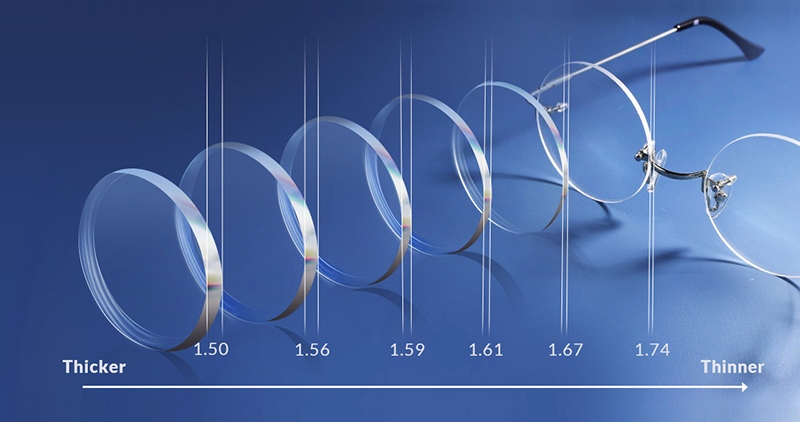Knowing The Difference Between 1.50 And 1.74
When you’re looking to purchase your next pair of prescription eyeglasses, you might come across the term “lens index”. Sometimes referred to as the “index of refraction” or the “refractive index,” this number is a measurement of how efficiently a specific lens material bends light.
Understanding these numbers and how they relate to your eyesight is an important part of choosing the right lenses for you.

What does lens index mean?
As the prescription strength increases, lenses get thicker and heavier. High-index material provides thinner and lighter lenses, which makes them a good option for those who have a strong prescription. The higher the index, the lighter and thinner the lens will be. Typically, the index numbers range from 1.50 to 1.74. Payne Glasses not only offers all of these indexes, but (much like your optometrist would) our online ordering system automatically recommends the best index for your prescription!
Here are all the options we offer and what they mean to you:
1.50 Standard Index
These plastic lenses were the first alternative to glass. We include the 1.50 Standard Index lenses in all of our frame prices. In other words, if you see a $5.95 pair of frames, the price not only includes said frame but also 1.50 lenses with it.The 1.50 Standard Index lenses are the thickest lenses you can purchase for a typical pair of prescription glasses, but benefit from superior clarity. These work best for prescriptions that fall between -3.00 and +3.00. You will find that because of the properties of the 1.50, they will need to be in a full-rim frame that supports all sides of the lens in order to prevent cracking. The material needs to be coated, however, because it scratches easily and doesn’t block UV radiation well.
1.56 Mid-Index
The 1.56 is 15% thinner than the 1.50 Standard and combines great optics with a thin, lightweight design. These work with prescriptions ranging from -3.75 to +2 . We recommend them for full-rim eyeglass frames, but they are not suitable for use during sports.
1.59 Polycarbonate
1.59 Polycarbonate lenses are made of material ideal for active use, including glasses for kids, sports goggles, and safety glasses. The 1.59 Polycarbonate is good for rimless glasses, which (though stylish) require a very durable lens material, because they lack the protection of a full frame. 1.59 does not have the best optical clarity. The most common problem with Polycarbonate is the high amount of chromatic aberrations (an optical distortion that may cause colored halos around lights or blurred vision).
1.61 High Index
1.61 High-Index lenses bend light more efficiently and have thinner edges than plastic lenses with the same prescription power. They require less material, which reduces their overall weight. The 1.61 are 20% thinner than 1.50 Standard Index lenses and are recommended for full-rim or semi-rimless frames. Suitable prescription range: -5.00 to +3.00
1.67 High Index
The 1.67 High-Index lenses are 30% thinner than 1.50 Standard Index lenses with the same prescription. For higher prescriptions, this lens material and index works well due to its reduced weight and edge thickness.
1.74 High Index
1.74 High-Index lenses are the thinnest and lightest lenses you can buy from Payne Glasses. We reccomend these for individuals with a strong eyeglass prescription, because they are aspheric in design. 1.74 High Index lenses are made thinner and flatter than standard spherical lenses, which helps reduce the magnification of the eyes. Suitable prescription range: -10.00 to +8.00
What factors should I consider when choosing my lens index?
Prescription is not the only factor used to determine which lenses are right for you. PD, frame type, and lifestyle needs are also indicators.
Pupillary Distance
Pupillary Distance, or PD, is the distance between each pupil and the center of the bridge of your nose. Some wearers with a smaller average PD can’t use Standard and require something more custom. Thanks to modern technology, this is where Digital Free-form lenses come in. At Payne Glasses, we offer Digital Free-form Lenses at a lower cost than our competitors. For more information about Standard vs. Free-form lenses, watch this helpful video.
Frame Type
Depending on the frames you choose, you may be better off with a certain lens index. Fortunately, our online ordering process automatically recommends which indexes will work best with the frames you choose. For example, if you have a stronger prescription and choose a metal or semi-rimless pair of glasses, our order process will likely recommend a higher index so the lenses are thinner, more durable, and do not show outside the frame as much. If you have that same prescription and order a thick plastic or acetate frame, lower indexes (AKA thicker lenses) are lower-cost options whose thickness can be hidden by the natural thickness of the plastic/acetate frame. This is why ordering different pairs at Payne may also result in different index recommendations.
Lifestyle
If your day-to-day routine includes intensive labor work or exercise, we recommend a more durable index..
Lenses with a strong prescription power, even if they are high-index, can “shrink” your face when worn. This may create the illusion that frames are larger than they really are. An optometrist can help you determine how to adjust frame size to make up for this illusion.
We offer high-index lenses at an affordable price with extra value additions such as anti-scratch, anti-reflective, and 100% UV protection. We use the leading technology to craft each pair of lenses, including singles and progressives. Check out more on Payne’s high-index lenses or start searching for your next pair of eyeglasses online today.












